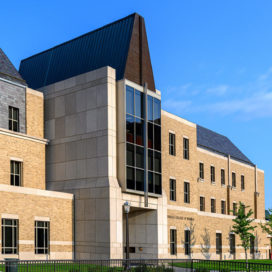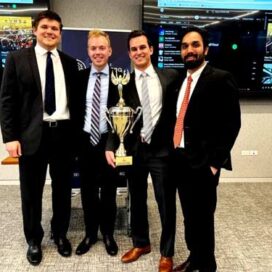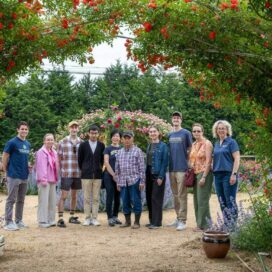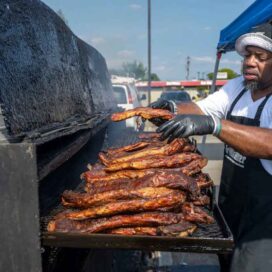“Greatest Generation” core of volunteers: Who will fill their shoes?
Published: August 3, 2007 / Author: Mary Writer
Shortly after he retired eight years ago, Carlton Doane told his pastor, “I want to feed the hungry.” With the pastor’s encouragement, Mr. Doane started “Free Will Meals.”
Now his church, Canton UMC in Canton, N.Y., opens its doors three Wednesday nights a month to anyone who would like a free home-cooked meal: the needy, the lonely, senior citizens and people who are just too busy to cook. Diners’ “free will” donations cover the costs of the meals.
Eight years and 30,000 meals later, Mr. Doane is still the driving force behind the program — putting in two days a week at the church, enlisting volunteers and making sure everything runs
smoothly.
Mr. Doane, 70, is typical of many volunteers of his generation: generous with his time, reliable, steady and committed to the long-term. Or, as he likes to put it, “I retired in order to volunteer.”
Mr. Doane is part of a generation that has been “an extraordinary group of volunteers,” writes D. Scott Martin in the Volunteer Management Review. “They filled our daytime positions for the last 30 years and were instrumental in enabling our organizations to grow and expand.”
But as members of the “Greatest Generation” (born 1911-1924) and their younger counterparts, the “Silent Generation” (born 1925-1945) become too old or frail to volunteer, many church leaders and nonprofit managers are worried: Will the next generation — the Baby Boomers — step up to the plate?
Different values
Studies are not projecting a hopeful outlook. The 77 million members of the Baby Boomer generation (born 1946-1964) have not been as active in giving and volunteering as much as previous generations. In 2005, only about a third of Boomers volunteered for formal organizations.
A 2004 report by the Harvard School of Public Health identified the Greatest Generation as “exceptional” in terms of the number of people who volunteered well into their 70s-and noted that Boomers have been “far less civically engaged than the Greatest Generation at every stage to date.”
A big portion of the volunteer workload is being shouldered by members of the Greatest Generation and the Silent Generation, according to Herb Bowman, advisor to the Rocky Mountain Conference Older Adult Council.
“Unfortunately, I’m not seeing a whole lot of interest in volunteering from the Baby Boomers,” he said. “And what I’m hearing from the next generation [Generation X, born 1965-1976] is, ‘We’re too busy.’ They’re raising their kids, and their volunteer work tends to relate to school and athletics and other childoriented activities.”
As an example, Mr. Bowman cited a visitation program for shut-ins in his church, Littleton UMC
in Littleton, Colo. About 95 percent of the program’s volunteers are in their 70s and older.
“My problem now is that, when these people go into nursing homes, I have to find someone to visit them and to take on their duties of visiting three to four people, too,” he said. “It’s getting more and more difficult.”
One thing is for sure: the Boomers think much differently than the previous two generations, and getting them to shoulder the volunteering burden will demand new strategies from churches and nonprofit managers.
“Look at a photo of a men’s Bible study class from the Greatest Generation,” said the Rev. Dr. Richard H. Gentzler Jr., director of the Center on Aging and Older Adult Ministries for the General Board of Discipleship. “They all wore the same suits and ties. They were pretty conformist, not in a negative sense, but they worked together. They were builders and problem-solvers.”
Boomers, on the other hand, are much more individualistic, Dr. Gentzler says. While a Greatest Generation member might tithe to a church, for instance, Boomers are more likely to make selective donations to programs they believe will make a difference.
“The younger generations have much less institutional loyalty than the older generations,” agrees Thomas J. Harvey, director of the Master of Nonprofit Administration program at the University of Notre Dame’s Mendoza College of Business. And they have a very different outlook on life and community service, he added.
“Members of the Greatest Generation have the Great Depression in their experience arsenal,” Mr. Harvey said. “They understand being poor, because many of them were poor when everyone was poor. Now, it’s easier to blame people if they’re poor.”
The Depression and World War II also forged determination, frugality, selfreliance, a sense of duty and a lifelong habit of service for many members of the Greatest Generation.
“I grew up on a farm,” said Vera Haney, 84, a member of Littleton UMC and a lifelong volunteer for numerous church and community organizations. “Neighbor helped neighbor, and we never kept track.”
Ms. Haney still volunteers on several church committees, but relies on a cane and can no longer do her own yard work. A neighbor does it for her, and won’t accept pay. “She says to me, ‘How much volunteering have you done, Vera?'” Ms. Haney said. “I think what you sow is what you reap.”
The Rev. Judith Pruess-Mellow, a United Methodist deacon who is on special appointment as executive director of Senior New Ways in northern California, says many Boomers like her often make mid-life career changes these days, knowing they won’t have the kind of pension their
parents did from having worked at the same company all their life.
Born in 1946 — the upper edge of the Baby Boomer generation — Dr. Pruess- Mellow left a career in educational psychology and went into ministry in 1995. “I feel like I’m just getting started, and I’m wondering what money I’m going to retire on when I do get ready to retire,” she said.
And while having a pension gives current retirees the freedom to volunteer, the “lack of time” doesn’t entirely explain the Boomer gap in volunteering. The Harvard report says that “people do not automatically volunteer in greater numbers just because they have the time… instead, volunteering in mid-life seems to be associated with having more rather than fewer obligations and commitments, and with being engaged in other aspects of life such as working or parenting.”
That means Boomers tend to be “sprinters,” as far as volunteering, and more willing to put focused energy on short-term projects, Dr. Pruess-Mellow says, while members of the Greatest Generation are the “marathoners.” So volunteer coordinators for nonprofits shouldn’t expect Boomers to “show up every Monday for a million years.” It’s just not their style.
Still, with some creativity and understanding of Boomer thinking, she thinks nonprofits can get more Boomers engaged.
“I think that when Boomers do finally retire, they will have a real desire to volunteer, as long as the opportunities are interesting and authentic,” Dr. Pruess-Mellow said. “There’s plenty of energy to commit, but nonprofits are going to have to tap into the passions of Boomers.”
To foster Boomer volunteering, churches need to be mindful of creating plenty of “entry points” for people at midlife or older, Dr. Gentzler added. If churches have programs aimed at children and youth, but neglect programs for the parents themselves, they shouldn’t be surprised at the results.
“When the kids grow up and move away, we’ll find the parents aren’t as attentive to their spiritual growth,” Dr. Gentzler said. “They’re going to hop in their RVs and spend their weekends at the lake.
“If we help people to age faithfully, then they will be engaged in mission and will be change agents on behalf of Christ,” he added. “If we are open in helping people understand the positive aspects of aging, we are in effect setting up a bright future for the church.”
###
/news_and_events/news_articles/article/1184/greatest-generation-core-of-volunteers-who-will-fill-their-shoes
Related Stories




